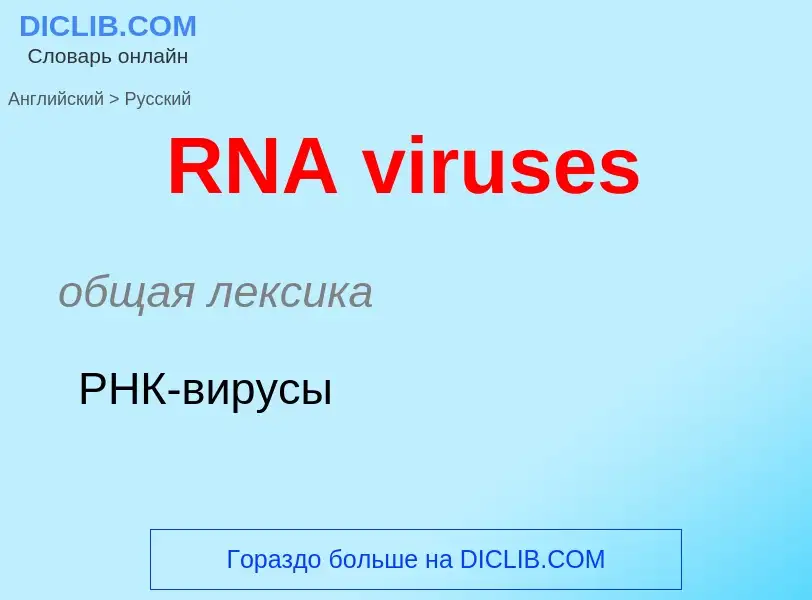Μετάφραση και ανάλυση λέξεων από την τεχνητή νοημοσύνη ChatGPT
Σε αυτήν τη σελίδα μπορείτε να λάβετε μια λεπτομερή ανάλυση μιας λέξης ή μιας φράσης, η οποία δημιουργήθηκε χρησιμοποιώντας το ChatGPT, την καλύτερη τεχνολογία τεχνητής νοημοσύνης μέχρι σήμερα:
- πώς χρησιμοποιείται η λέξη
- συχνότητα χρήσης
- χρησιμοποιείται πιο συχνά στον προφορικό ή γραπτό λόγο
- επιλογές μετάφρασης λέξεων
- παραδείγματα χρήσης (πολλές φράσεις με μετάφραση)
- ετυμολογία
RNA viruses - translation to ρωσικά
общая лексика
РНК-вирусы
общая лексика
репликация РНК
общая лексика
рибосомная РНК
рРНК
Βικιπαίδεια
Baltimore classification is a system used to classify viruses based on their manner of messenger RNA (mRNA) synthesis. By organizing viruses based on their manner of mRNA production, it is possible to study viruses that behave similarly as a distinct group. Seven Baltimore groups are described that take into consideration whether the viral genome is made of deoxyribonucleic acid (DNA) or ribonucleic acid (RNA), whether the genome is single- or double-stranded, and whether the sense of a single-stranded RNA genome is positive or negative.
Baltimore classification also closely corresponds to the manner of replicating the genome, so Baltimore classification is useful for grouping viruses together for both transcription and replication. Certain subjects pertaining to viruses are associated with multiple, specific Baltimore groups, such as specific forms of translation of mRNA and the host range of different types of viruses. Structural characteristics such as the shape of the viral capsid, which stores the viral genome, and the evolutionary history of viruses are not necessarily related to Baltimore groups.
Baltimore classification was created in 1971 by virologist David Baltimore. Since then, it has become common among virologists to use Baltimore classification alongside standard virus taxonomy, which is based on evolutionary history. In 2018 and 2019, Baltimore classification was partially integrated into virus taxonomy based on evidence that certain groups were descended from common ancestors. Various realms, kingdoms, and phyla now correspond to specific Baltimore groups.


![HIV-1]] (group VI). HIV-1]] (group VI).](https://commons.wikimedia.org/wiki/Special:FilePath/Molecules-23-02475-g002.webp?width=200)
![HIV-1]] (group VI). HIV-1]] (group VI).](https://commons.wikimedia.org/wiki/Special:FilePath/Molecules-23-02475-g003.webp?width=200)



![[[Phylogenetic tree]] with phylum branches highlighted. ''Negarnaviricota'' (brown), ''Duplornaviricota'' (green), ''Kitrinoviricota'' (pink), ''Pisuviricota'' (blue), and ''Lenarviricota'' (yellow) [[Phylogenetic tree]] with phylum branches highlighted. ''Negarnaviricota'' (brown), ''Duplornaviricota'' (green), ''Kitrinoviricota'' (pink), ''Pisuviricota'' (blue), and ''Lenarviricota'' (yellow)](https://commons.wikimedia.org/wiki/Special:FilePath/MBio.02329-18.F1.large.jpg?width=200)
![[[Lymphocytic choriomeningitis virus]] (''[[Arenaviridae]]'') [[Lymphocytic choriomeningitis virus]] (''[[Arenaviridae]]'')](https://commons.wikimedia.org/wiki/Special:FilePath/Lymphocytic choriomeningitis virus.jpg?width=200)
![[[Hantavirus]] (''[[Bunyaviridae]]'') [[Hantavirus]] (''[[Bunyaviridae]]'')](https://commons.wikimedia.org/wiki/Special:FilePath/Sin Nombre virus Hanta TEM 1137 lores.jpg?width=200)
![[[Marburg virus]] (''[[Filoviridae]]'') [[Marburg virus]] (''[[Filoviridae]]'')](https://commons.wikimedia.org/wiki/Special:FilePath/Marburg virus.jpg?width=200)
![[[Ebola virus]] (''[[Filoviridae]]'') [[Ebola virus]] (''[[Filoviridae]]'')](https://commons.wikimedia.org/wiki/Special:FilePath/Ebola virions.png?width=200)
![[[Influenza]] (''[[Orthomyxoviridae]]'') [[Influenza]] (''[[Orthomyxoviridae]]'')](https://commons.wikimedia.org/wiki/Special:FilePath/Influenza virus particle 8430 lores.jpg?width=200)
![[[Mumps virus]] (''[[Paramyxoviridae]]'') [[Mumps virus]] (''[[Paramyxoviridae]]'')](https://commons.wikimedia.org/wiki/Special:FilePath/Mumps virus, negative stained TEM 8758 lores.jpg?width=200)
![[[Human respiratory syncytial virus]] (''[[Paramyxoviridae]]'') [[Human respiratory syncytial virus]] (''[[Paramyxoviridae]]'')](https://commons.wikimedia.org/wiki/Special:FilePath/Respiratory Syncytial Virus (RSV) EM PHIL 2175 lores.jpg?width=200)
![[[Parainfluenza]] (''[[Paramyxoviridae]]'') [[Parainfluenza]] (''[[Paramyxoviridae]]'')](https://commons.wikimedia.org/wiki/Special:FilePath/Parainfluenza virus TEM PHIL 271 lores.jpg?width=200)
![[[Vesicular stomatitis virus]] (''[[Rhabdoviridae]]'') [[Vesicular stomatitis virus]] (''[[Rhabdoviridae]]'')](https://commons.wikimedia.org/wiki/Special:FilePath/Vesicular stomatitis virus (VSV) EM 18 lores.jpg?width=200)




![An example of a fully-assembled small subunit of ribosomal RNA in prokaryotes, specifically ''[[Thermus thermophilus]]''. The actual ribosomal RNA (16S) is shown coiled in orange with ribosomal proteins attaching in blue. An example of a fully-assembled small subunit of ribosomal RNA in prokaryotes, specifically ''[[Thermus thermophilus]]''. The actual ribosomal RNA (16S) is shown coiled in orange with ribosomal proteins attaching in blue.](https://commons.wikimedia.org/wiki/Special:FilePath/010 small subunit-1FKA.gif?width=200)

![Small subunit ribosomal RNA, 5' domain taken from the [[Rfam]] database. This example is [http://rfam.xfam.org/family/RF00177 RF00177], a fragment from an uncultured bacterium. Small subunit ribosomal RNA, 5' domain taken from the [[Rfam]] database. This example is [http://rfam.xfam.org/family/RF00177 RF00177], a fragment from an uncultured bacterium.](https://commons.wikimedia.org/wiki/Special:FilePath/RF00177.jpg?width=200)


